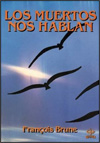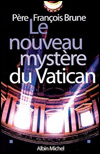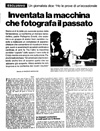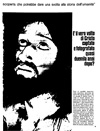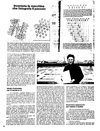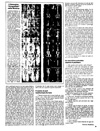The Chronovisor Project, The Lady in Blue - Javier Sierra
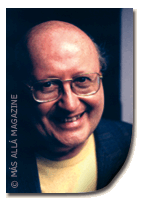
The French priest François Brune became known in Europe during the late 1980s thanks to a book entitled The Dead Speak to Us. In that book he stated that, by means of elaborate technological processes, it was possible to communicate with the realm of the spirits. But Father Brune also knew about details relating to a certain machine that would photograph the past, designed in the 1950s by the Vatican. The Lady in Blue speaks extensively about this, but the following interview between Javier Sierra and Father Brune in Madrid reveals additional details on the subject.
The month of October 2003 was one of the rainiest that I can recall. Just four days before the feast of All Saints, I was thinking that the date chosen by Father François Brune for our interview couldn’t be more appropriate. A small hotel in the heart of Madrid, close to the Plaza de la Ópera, served as the scene of our conversation concerning the Chronovisor and the work of the Benedictine Pellegrino Ernetti. An expert in pre-polyphony who served as inspiration for the character Giusseppe Baldi in The Lady in Blue, Ernetti had died in 1994 without my having been able to gain access to his secrets. I thought that perhaps Brune, a personal friend of Ernetti for many years, would be able to help me to find out more about the Chronovisor.
Brune had first met the Benedictine Father Ernetti in 1964, almost eight years before the latter’s story would appear in various periodicals. He even devoted an entire chapter of his 1990 book The Dead Speak to Us to Ernetti. In it he combines the scientific Vatican project for capturing images and sounds from the past with matters more related to parapsychology, such as “psychophonies,” the controversial recordings of supposed voices from the beyond. I needed to know more. Much more than he had related in that book or even what he had revealed months before our meeting in another book devoted to the Chronovisor, The New Vatican Mystery.
I wanted to know when in fact Brune had first heard of the Chronovisor project. What had been his impression of it.
At 4:30 sharp, we were seated in the hotel “HH” in Madrid. Father Brune was dressed as a clergyman, but sporting sneakers.
“You knew Father Ernetti well, didn’t you?”
My question surprised him. I had decided to get straight to the point, and Brune seemed willing enough to speak.
“Yes, of course,” he responded, smiling. “We saw each other many times in Venice, on the island of San Giorgio Maggiore.”
“How did you meet him?”
“I studied two years at the Biblical Institute in Rome. And one time, on my way there, I decided to hitchhike to Venice. On the ferry to the island of San Giorgio I met Father Ernetti, and we began talking about my studies. It was that simple.”
“And did he speak then about the Chronovisor project?”
“Not exactly. Although, of course, it should have been easier to speak with a priest than with someone outside the clergy, and above all with a foreign priest for whom it would be more difficult to understand the language. First we spoke about the interpretation of the New Testament and about how in our era many were attempting to strip biblical history of its marvelous components. The world is critical of miracles, healings, exorcisms... anything that seems supernatural. And from there we soon went on to the subject of communication with the beyond. Thus, little by little, Ernetti ended up by bringing up something that was of even greater interest to me.”
“The Chronovisor!”
Brune’s face lit up. “Exactly,” he replied.
“What year was that?”
“In 1964.”
“And what exactly became of the Chronovisor?”
“I saw Ernetti for the last time a few months before his death in 1994. He told me that they had just had a meeting in the Vatican with the last living scientists who had collaborated on its construction. There had been four cardinals and other scientists, and he told me that they had discussed all that they knew. The unfortunate thing was that Ernetti would only divulge the name of scientists once they were already dead.
“What do you mean that they told him everything? Wasn’t the Vatican already well informed about the Chronovisor?”
“You see, as far as I know, the Chronovisor had been dismantled. But Ernetti didn’t have much trust in the Vatican. Already some years before he had told me that he had deposited his plans with a notary in both Switzerland and Japan.”
“Let’s talk about something else, Father Brune,” I asked. “You might know that the first time the Chronovisor was referred to in the press was in 1972. And that then, the first news about it was accompanied by a supposed photo of Jesus Christ obtained by this machine...”
“It was a fake photo, of course.”
“Please tell me about it.”
“It’s simple. Some people who worked on the Chronovisor said that the machine couldn’t take close-ups, only general ones. With nowhere near as much detail as in that photo. It wasn’t possible to obtain an image that was so precise.”
“But did they use the Chronovisor to see the Passion of Christ?”
“Yes.”
“In what year did they do that?”
“I think it was before 1960.”
“And that close-up image of Jesus?”
“It was taken from the most famous crucifix of Collevallenza. When it was published, they used it to attack Father Ernetti, accusing him of fraud. But Ernetti had already informed me that it wasn’t from the Chronovisor, just as he’d told a reporter from the magazine Más Allá a few years before...”
I found that funny. François Brune didn’t realize that the “reporter from the magazine Más Allá had been me. I had interviewed Pellegrino Ernetti one year before his death; and although he had not told me much, he had insisted that the alleged photo of Jesus had not been obtained from his equipment.
At last the moment of truth had arrived. The moment when I asked Brune if, in addition to his priest-to-priest conversations with Ernetti, he had been allowed to see films or photographs from the Chronovisor. Brune was categorical.
“No,” he asserted. “Ernetti told me that he hadn’t kept any of it. He was urged by his superiors not to speak a word about it. And he suffered a lot due to this, because he never had the occasion to explain his discoveries to Science.
“But when I interviewed Ernetti in 1993, he told me that it had been Pope Pius XII who had prohibited him from speaking about it.”
“Yes, that’s right.”
“Do you have any idea why he was prohibited from doing so?”
“Brune shrugged his shoulders at my naivete.
“Well...” he hesitated. “Ernetti showed his recordings to the Pope as well as the President of Italy, Mussolini. And also to other scientists and cardinals, and their unanimous conclusion was that it was dangerous for humanity. I know that there exists an American science fiction novel that imagines what would happen if they discovered such an apparatus, and what the consequences would be for humanity. Because there wouldn’t be any secrets, whether scientific, political, economic, or any private lives. Everything would be transparent.”
“But if the Vatican had this apparatus, wouldn’t they ever use it?”
“It’s possible. I’m sorry, but I can’t help you any further.”
“Please answer my last question, Father,” I persevered. “Have you taken any steps with the Vatican to see if material on the Chronovisor could one day be seen?”
“No, I haven’t done that because...it would not be possible.”
“As a Catholic priest, you couldn’t...”
“I think it would be easier for you to find out than for me.” He smiled. There are some people in the Vatican who are interested in questions concerning the paranormal, and perhaps they could help you. I know an Italian priest who speaks German and who founded an institute of parapsychology in Innsbruck, Father Andrea Resch. I visited him two times. Perhaps he would know where to begin. He told me two or three years ago that he had been in Rome with a small group that studied paranormal phenomena, and that they were quite familiar with my books and presentations. But that was before the publication of my book about the Chronovisor.”
“And after all these years, what is your take on this subject?”
“That the Chronovisor existed,” he replied definitively. “Of that I have no doubt.”
The Columbus Dispatch



